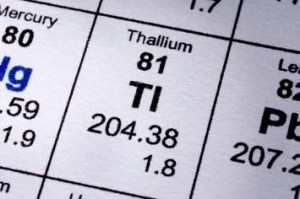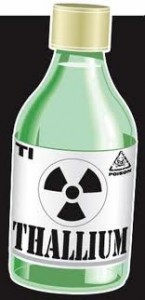The Chemist as Murderer
On January 14th, a 39-year-old computer engineer was admitted to Princeton University Hospital in New Jersey with nagging, flu-like symptoms. The man was nauseated, suffering from severe joint pains, wracked by a strange, convulsive trembling in his legs. Doctors at the hospital tried one treatment after another but Xiaoye Wang only became weaker.
 Finally, a nurse at the hospital stepped hesitantly forward. She remembered a 1995 case in China in which a student at Beijing University became mysteriously ill. The cause was eventually found to be poisoning by the extremely toxic element thallium. The young woman received a life-saving antidote although she suffered lingering disabilities from the attack.
Finally, a nurse at the hospital stepped hesitantly forward. She remembered a 1995 case in China in which a student at Beijing University became mysteriously ill. The cause was eventually found to be poisoning by the extremely toxic element thallium. The young woman received a life-saving antidote although she suffered lingering disabilities from the attack.
And – as the nurse recalled from the highly publicized case – the student's symptoms were eerily similar to Wang's. During the man's hospital stay, he'd developed new signs of worsening illness – he'd lost his hair; his skin had thickened; his hands and feet had gone numb.
The Princeton doctors were dubious about a fairly exotic poison use, but they were running out of ideas. They desperately wanted answers. So although but hey couldn't find an in-state laboratory to do the tests, they sent blood and urine samples out of state. And to their shock, the tests proved the nurse right. The lab had discovered a shockingly high level of thallium in Wang's body.
On January 25, as soon as the results were in, the hospital contacted the New Jersey Poison Control Center for help. The doctors had no experience with thallium poisoning. They needed to know how to save their patient.
As Steven Marcus, head of the poison control center, told the Newark Star-Ledger, his first reaction was that no one suffers an accidental thallium poisoning. Thallium is a dangerous and carefully regulated poison, mostly found in laboratories. "It's either attempted suicide or homicide," he said. Marcus added that he knew of only one good antidote for thallium poisoning, a medication called Prussian Blue.
 Rather ironically, the antidote's name derives from another famously lethal substance. Prussian Blue refers to cyanide (a component of the medication) which can be used to produce a royal blue pigment. Some cyanide formulas are lethal, notably hydrogen cyanide or potassium cyanide. But mixed into the tidy antidote formula (brand name Radiogardase) cyanide merely becomes part of a chemical chain that wraps itself around thallium, binding it up, and allowing the body to remove the poison.
Rather ironically, the antidote's name derives from another famously lethal substance. Prussian Blue refers to cyanide (a component of the medication) which can be used to produce a royal blue pigment. Some cyanide formulas are lethal, notably hydrogen cyanide or potassium cyanide. But mixed into the tidy antidote formula (brand name Radiogardase) cyanide merely becomes part of a chemical chain that wraps itself around thallium, binding it up, and allowing the body to remove the poison.
By the time, the New Jersey doctors were able to secure the antidote though, it was too late. He died on January 26 leaving doctors – and now criminal investigators – to answer the question raised by Steven Marcus. Was it suicide or was it murder?
I actually devoted a chapter of my book, The Poisoner's Handbook, to thallium because it's such a fascinating poison. Agatha Christie knew this long before I did – it's the star of her murder mystery story, The Pale Horse. A key to the Christie novel is that thallium appears to be a near perfect homicidal poison is that it is tasteless, odorless, mixes smoothly and easy into food and drink. A key to my non-fiction tale of five thallium deaths in 1930s New York is that this is also a highly detectable poison. Or as I wrote in the book:
" In the manner of other metallic poisons, such as arsenic, thallium stayed stubbornly in the body, permeating the tissues for weeks and even months after death. Any knowledgeable forensic toxicologist could find it.
It was, one might say, a chemist's poison."
Which was exactly what the authorities in New Jersey concluded as well.
There was no evidence that the dead man was suicidal. But further investigation found that Wang was involved in an angry divorce which included disagreements over property division and custody of a two-year-old son. His wife, Tianie "Heidi" Li was a research chemist at Bristol-Myers-Squibb, working in a laboratory that included access to thallium.
Tianie Li in Court/photo credit ChinaSmack.com
On February 8, Li, 40, was charged with murdering her husband. She has since pleaded not guilty and is also seeking to have her bail, currently set at more than $4 million reduced.
Let's acknowledge first that Li has not been convicted of murder. Still her arrest raises some intriguing questions on the subject of poison murders. For instance, does one need a chemistry degree to be a thallium killer?
Actually, the answer to that one is an easy no. The killer does need to have some specialized knowledge though. Thallium (unlike cyanide) is not a well-known toxic substance. So while the killer in my own book was a high school graduate, those murders occurred at a time when thallium was a widely available pesticide. The U.S. government removed it from household markets in 1972, though, because of the risks.
I'm aware of one other well-publicized thallium murder that involved a killer with chemical training and that occurred in Alturas, Florida in the late 1980s. In that case, a Mensa member and troubled former chemist became annoyed with his neighbors, who he perceived as noisy and inconsiderate.
The angry chemist, George Trepal, left them an anonymous gift of Coca Cola spiked with thallium. The poisoned sodas killed one neighbor and hospitalized two others for months. Trepal was not a scientist with a happy history. At the time of the deaths, he had a criminal record, having served time for working as chief chemist for a methamphetamine laboratory. In 1991, he was convicted of one count of first degree murder and six counts of attempted murder. He remains on Florida's death row today and is the subject of a book titled Poison Mind.
But investigators were never sure how Joann Curley of Wilkes-Barre, Pennsylvania, decided to kill her husband, Robert, by putting thallium in his iced-tea. Curley confessed to the murder in 1996, after a relentless five year investigation into his death. And Ann Perry of Long Island, sentenced in 2002 for killing her abusive boyfriend with thallium-laced milkshakes, had no special chemical knowledge either.
The acclaimed British author, John Emsley, who specializes in writing about chemistry in books such as The Elements of Murder has suggested that it's mystery writers like Christie who really brought thallium into public's mind as a murder weapon. Among the examples he gives is the case of Graham Young, a worker in a British photographic instrument company, who killed two of his co-workers in 1971 by mixing thallium into their coffee.
Image credit: Daily Mail
As news of Li's murder arrest has spread, increasingly the stories have been framed around chemist-as-killer. "Chemist killed her husband with radioactive poison to avoid going through a divorce" was the headline in Britain's Daily Mail. "NJ chemist pleads not guilty to poisoning husband," was a more stately lead in BusinessWeek. And, of course, some of this is just headline writing shorthand for an event.
But make no mistake. The history of thallium homicides mostly serves as a reminder that any of us can play at the poison murder game. Yes, Dr. Li had specialized knowledge and access to thallium but as a Joann Curley proves, that's not necessary for a determined killer. If Li is convicted, being a trained chemist won't have made her anything special. She'll just be another one of those over-confident murderers who ended up getting caught.
But I'd like to add this footnote – she'll also be another murderer caught by a chemist.

Deborah Blum's Blog
- Deborah Blum's profile
- 426 followers





